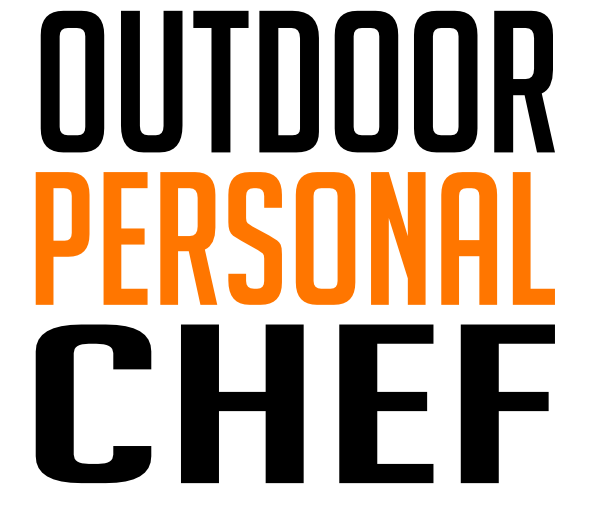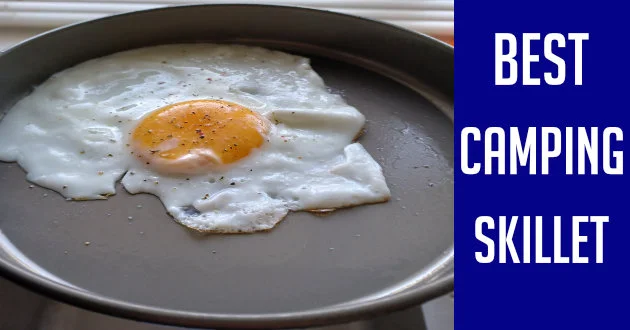The Best Camping Skillet for gas stove or open fire is a light-weight hard-anodised aluminium skillet. This skillet will heat better, scald or burn your food less and packs away easy. If camping out of a vehicle I would choose a cast iron skillet for better heat control and the best option for searing foods.
They always say – Breakfast is the most important meal of the day. To make the best breakfast when camping, you need the best camping skillet. Using my years of knowledge as a chef and experience in outdoor cooking will give you the information you need to choose the best camping skillet or pan for your next outdoor trip.
I will also give you my recommended list of skillets I would buy at the end of this article. I put the list at the end because I want you to know first. I’m not here to sell you a skillet. I’m here to give you the knowledge to make the best choice.
What Kind of Pan is Best for Camping?
What kind of pan is best for camping depends on what you intend to do.
If you are backpacking across the backcountry and setting up in a far-off location, you will want a skillet that is light, easy to store, has good heat distribution and has some non-stick properties.
If you are camping with the family from the back of your car or campervan, then you can afford to have a more robust skillet that doesn’t have to be lightweight and can handle a huge range of cooking needs.
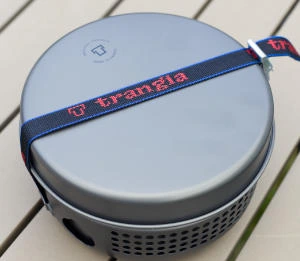
Choosing the Best Skillet for Camping.
When choosing the best skillet or pan for camping, regardless of where you are camping, there are a few things you need to keep in mind and prioritise. Here are my top 3 prioritise when it comes to choosing a camping skillet or pan:
- Heat Distribution – When I choose a skillet or pan for camping, I want a pan that has even heat distribution so that my food doesn’t scald or burn. This is my #1 because you can have the lightest pan in the world that is rugged, scratch resistant and looks shiny and new. If that skillet or pan burns your food as soon as it touches heat, it’s a pile of Sh$t.
- Non-Stick – For a skillet, especially if you want something with some non-stick properties. Out of all my cooking equipment, my skillet is the only camping cookware where I would consider buying it non-stick. In doing so, I know I will have to take care of this, wrap it when storing and only use the right utensil so it doesn’t scratch. If I don’t go with a non-stick coating, I will choose a coating that will prevent sticking. I’ll go into this further on.
- Weight – After the above two, I consider the item’s weight. If I am hiking a distance, I want something light and compact but also have my top 2 conditions included. Having a skillet with a foldable or removable handle is ideal, as it helps when storing and carrying your skillet. If I am not hiking a distance and have a vehicle nearby, I will opt for a pan with a heavier base that can cook a wider range of foods.
Keeping this list of priorities helps me choose the best camping skillet for my needs. Having the right tool for the job is important, and your camping skillet should be considered a tool to help you cook good or possible great food.
Best Camping Skillet for a Camping Stove
The best skillet, in my opinion, for a camping stove is one that will be lightweight, can pack away without taking up much room, won’t burn my food and is durable.
I tend to always go with a skillet made from aluminum which has been treated with a hard-anodised coating and has a removable or folding handle.
Choosing an aluminum skillet for a camping stove means choosing a lightweight skillet. Aluminum also offers better heat distribution than other materials like Stainless steel or Titanium.
Stainless Steel and Titanium are piss poor for distributing the heat, and they will scald or burn your food. I will stay clear of these two materials unless you are boiling water.
Choosing a hard-anodised aluminum skillet also helps increase heat distribution while adding a non-stick element to your camping skillet.
Unlike non-stick skillets and pans, hard-anodised cookware is more rugged, won’t scratch or chip, and the treatment process is natural.
Non-stick coatings are considered not to be the healthiest way to cook food so going with the hard-anodisation option for me seems to be a better choice.
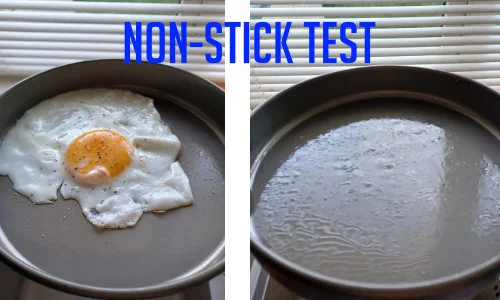
Best Camping Skillet for an Open Fire
If you are cooking over an open fire on camping grounds or have a vehicle nearby, then hands down, you will want to go with a cast Iron skillet every day of the week.
Consider your cast Iron skillet your multi-tool; your swiss army knife for cooking. A cast Iron skillet will give you many more options when cooking your food. A properly seasoned cast iron skillet will be non-stick and a natural healthy non-stick.
The heavy base means that when you preheat that bad boy and sear meats, you will get the best flavour into that meat. The sound alone of meat searing on a cast Iron skillet is enough to set your mouth watering like Niagra falls.
A seasoned cast Iron skillet will also fry your eggs to perfection with just a little heat. Perfect for breakfast. You could even bring your cast iron skillet into your tent or camper to heat up before bed, as the skillet holds heat for some time after use. Make sure you place it on a surface that won’t melt or catch fire.
I will go with a hard-anodised skillet if you are hiking and using an open fire. Make sure you cook over hot coals and not a roaring flame. Cooking over hot coals helps you control the heat better and won’t burn your hand as much.
Don’t get me wrong, if you want to lug around a big old heavy-ass cast Iron skillet, go ahead; it’s up to you.
When cooking while camping choosing the right tools for the right job is paramount. If you can sacrifice weight to cook better food, then go for it. The heavier the skillet or pan materials, the better heat transference you will get.
If you are enjoying this article why not read my article on 9 Must have Items for a cooking campsite which I think you might enjoy.
What is Heat Transferrence?
I go on a lot about heat transference and using the best materials, so you don’t scald or burn your food. As a chef, I always presume people know what I mean, but I will briefly go into what I mean by heat transference for those who may want to know more.
Heat transference is how you transfer the heat from your cooking source, i.e. your camping stove flame or open fire flame, through your skillet or pan to your food.
When we are camping, we often choose light materials to save weight. Light materials normally heat up extremely fast, which is great for conserving fuel but can be hard to control.
For a lot of cooking, especially on skillets or pans, you want to get that pan up to temp (as hot as possible). By getting your skillet up to temp, you can add nice colour to your meats or start boiling liquids fast. (Adding colour to your meats adds flavour, the browning of meats is the sugars caramelising and adds heaps of flavour.)
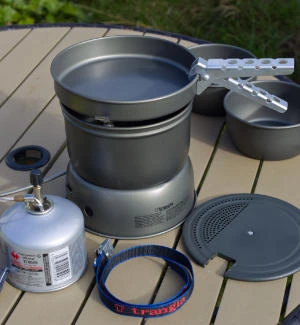
Sometimes having a scorching hot pan is not what you want, especially if you are cooking scrambled eggs or an omelette. For these, you want to be able to control your heat and apply low and gentle so you can control the cooking process.
Thin skillets and pans can often be difficult to control the heat, whereas a skillet or pan with a thicker base will heat up slower and is better for low-heat cooking.
Some materials conduct the heat from your flame across its surface better than others.
You will often see this if you put a stainless steel skillet or pot on a flame that is made of a thin base. You might see the oil brown in one spot or food stick to one area over others. The sides will scald sauces or discolour.
Stainless steel tends to be pretty poor at heating evenly when it’s thin and lightweight. This causes food to burn and scald because certain parts of the skillet heat hotter than other parts.
The best way to avoid this with stainless steel is to have a heavy base skillet or pan made of a material that conducts heat better, such as copper. This adds weight, and if camping, weight is something you want to cut down in most situations.
From testing, I have found that hard-anodised aluminum works best for me because it heats a little bit more even than other materials. You tend to get fewer hotspots, and the risk of burning or scalding is reduced.
Ok, I was meant to keep that brief, but my Chef’s brain took over. I hope I have given you a better understanding for those who may not have known.
Now that I have provided you with the knowledge to choose the best skillet for camping, I will give you my list of skillets and pans I would use without hesitation.
This list is made up of camping cookware that has all my top 3 priorities, and that will ensure you cook better food while out camping. Note: if you are crap at cooking, no pan in the world will improve your cooking skills. They will provide you with the best tool, practice and learn to use it (a little bit of chef humour).
Top List of Camping Skillets
Gas Stove Cooking – MSR Hard-Anodised Quick Skillet or the Hard-Anodised Trangia Pan
Vehicle Camping – 10inch Cast Iron Pan with Silicone grip
Outdoor Personal Chef is a participant in the Amazon Services LLC Associates Program, an affiliate advertising program designed to provide a means for sites to earn advertising fees by advertising and linking to Amazon.com. We also participate in other affiliate programs which compensate us for referring traffic.
